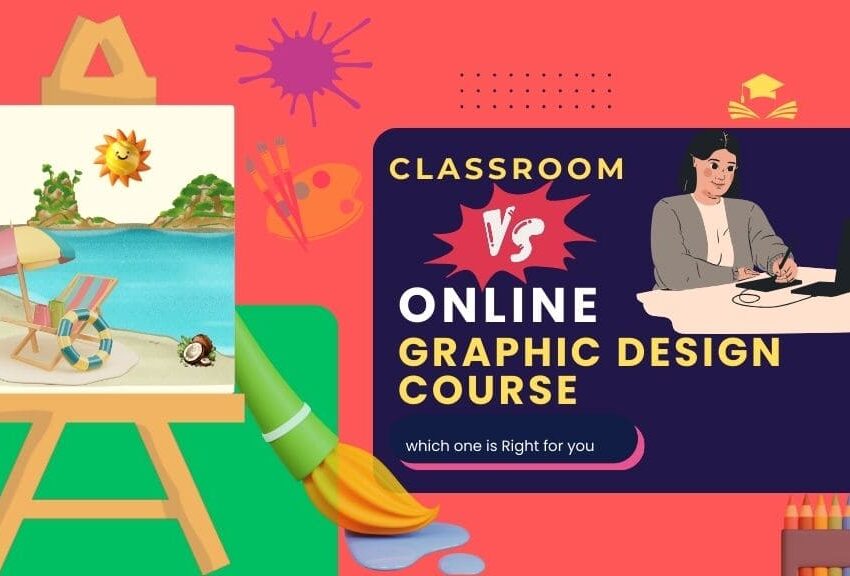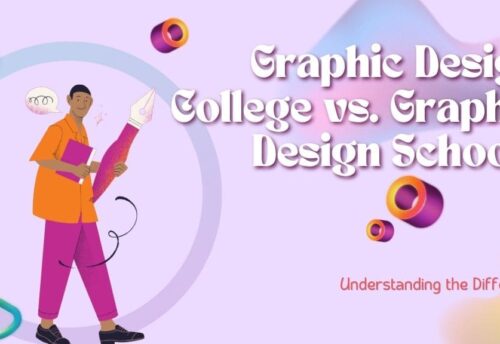
Classroom vs. Online Graphic Design Courses: Which One is Right for You?
Graphic design is one of the most in-demand and creatively fulfilling skills in today’s digital age. Whether you’re planning to become a professional designer or want to upskill for freelance opportunities, one key question arises:
Should you choose a classroom-based graphic design course or an online one?
Both learning modes have their advantages—and the “right” option depends on your learning style, schedule, goals, and preferences. In this post, we’ll break down the pros and cons of each to help you make an informed decision.
Classroom Graphic Design Courses
Benefits of Classroom Learning
1. Real-Time Interaction with Trainers
In a classroom setting, you can ask questions instantly, get immediate feedback, and have in-depth discussions with instructors and fellow students.
2. Hands-On Training & Supervised Practice
You get to work on live assignments and design exercises under direct supervision, which helps build your practical skills effectively.
3. Discipline & Routine
Physical classes offer structure and consistency. You’re more likely to stick to a schedule and complete your coursework on time.
4. Networking Opportunities
Interacting with classmates, instructors, and industry professionals in person can help you build valuable connections for internships or freelance work.
5. Access to Professional Tools & Infrastructure
Classroom courses often provide access to high-end computers, licensed Adobe software, printers, scanners, and even design studios—saving you initial investment costs.
Limitations of Classroom Learning
- Limited flexibility – Fixed schedules may clash with work, college, or personal commitments.
- Location-bound – You need to be in or near the institute’s location.
- Travel time and expenses – Daily commuting adds time and cost.
Online Graphic Design Courses
✅ Benefits of Online Learning
1. Learn Anytime, Anywhere
Study at your own pace from the comfort of your home. Great for working professionals, students, or those in remote locations.
2. Wide Range of Courses
From beginner to advanced levels, you can find hundreds of specialized online design courses on topics like UX/UI, typography, animation, branding, and more.
3. Cost-Effective
Online courses are generally more affordable than classroom training. You also save on travel and infrastructure costs.
4. Self-Paced Learning
If you’re a fast learner, you can complete the course quicker. If you’re new to design, you can take your time and repeat lessons as needed.
5. Access to Global Trainers
Learn from expert designers and industry leaders around the world—something not always possible locally.
❌ Limitations of Online Learning
- Lack of personal interaction – Support may be limited to email or chat; real-time feedback is often slower.
- Self-discipline needed – Without a fixed schedule, it’s easy to fall behind or lose motivation.
- Limited hands-on practice – Unless supplemented with live projects, you may not get enough real-world design experience.
Classroom vs. Online: Quick Comparison
| Feature | Classroom Course | Online Course |
|---|---|---|
| Learning Style | Interactive, guided | Self-paced, flexible |
| Schedule | Fixed, routine-based | Anytime, at your own pace |
| Cost | Higher (due to infrastructure) | Lower and often subscription-based |
| Feedback | Real-time, in person | Delayed or text-based |
| Networking | High (face-to-face interaction) | Limited (online forums, chats) |
| Tools & Software | Provided by institute | You need to invest personally |
| Location | Institute-bound | Learn from anywhere |
Who Should Choose Classroom Graphic Design Courses?
- Beginners who want structured learning
- Students looking for mentorship and peer interaction
- Professionals who need discipline and real-time support
- Anyone who prefers face-to-face communication
Who Should Choose Online Graphic Design Courses?
- Working professionals with limited time
- Freelancers or hobbyists wanting flexible upskilling
- Self-motivated learners
- Those living in remote areas or different cities
The Best of Both Worlds: Blended Learning
Some institutes offer hybrid graphic design training, where you get recorded modules + weekly live doubt sessions or studio practice. It’s a smart way to combine the flexibility of online learning with the depth of classroom interaction.
Final Thoughts
Whether you choose a classroom or online graphic design course, the most important thing is to stay consistent, practice regularly, and build a strong portfolio.
Each path can lead to a successful design career—you just need to pick the one that aligns with your lifestyle and learning preference.


